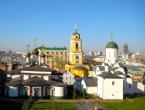Museum depot near Moscow opening hours. The only Moscow locomotive depot is Podmoskovnaya. You can get to the museum
Fan locomotive depot of Podmoskovnaya station
On July 30, on the eve of the railway worker's day, the grand opening of the museum and production complex at the station. Moscow region. The complex includes a historical part - a restored steam locomotive depot and a new motor car depot designed to service high-speed electric trains.
The opening ceremony of the complex was attended by the Minister of Culture of the Russian Federation V. Medinsky, the mayor of the city of Moscow S. Sobyanin, the president of Russian Railways, V. Yakunin.
Before the start of the event, the participants examined the exhibition complex of Russian Railways, located in the Center for Scientific and Technical Information and Libraries of Russian Railways at the Riga Railway Station of the capital.

From left to right: Moscow Mayor S.S. Sobyanin, President of Russian Railways V.I. Yakunin, Senior Vice President of Russian Railways V.A.Gapanovich, Head of the Moscow Railway V.I.Moldaver inspect the exposition of the exhibition complex JSC "Russian Railways"
After the inspection, the participants of the event went to the Podmoskovnaya station of the Moscow Railway, where they examined the objects of the museum and production complex. Arriving on the territory of the complex, the guests plunged into the atmosphere of the early 20th century.
Panorama of the museum part of the Complex at the station. Podmoskovnaya

Historical reconstruction of 1901
The historical complex includes the restored station building and the station master's house, as well as the restored water tower and the rolling locomotive depot. The Podmoskovnaya station and the locomotive depot began operating in 1901 as part of the Moscow-Vindavo-Rybinsk railway and are the oldest on the capital's main line. On the basis of buildings that survived the destruction during the war, a museum and production complex that has no analogues in Russia was created, where the museum exposition is combined with the repair and operation of existing steam locomotives.
The depot, together with a water tower, an office and a staff house, are on the list of objects of cultural heritage of the railway infrastructure on the territory of Moscow. The interior of the station recreates the atmosphere of the early 20th century with a ticket office, telegraph office, waiting rooms and a buffet.
A real historical and technical "rarity" is a fan-type locomotive depot with a turning circle, where, a century after the start of operation, steam locomotives are being repaired. In total, there are 7 operating steam locomotives of various years of construction in the park.
The honored guests got acquainted with the historical part of the Complex

To the lingering general whistle of six steam locomotives, the event participants honored with a minute of silence the memory of the workers of the Podmoskovnaya depot who died during the Great Patriotic War.
.jpg)
Turntable of a fan depot with steam locomotives
On the way to the fan depot, a surprise awaited the guests: traditional scrambled eggs, fried on a shovel in the locomotive's furnace, were prepared for them.
The participants of the event got acquainted with the exhibition exposition, organized in one of the stalls of the fan depot. The locomotive driver showed the honored guests a unique exhibit of the exhibition - a series E steam locomotive, specially cut to get acquainted with its structure and operating principle.

Guests of honor at the exhibit of the exhibition - a steam locomotive of the E series
On the same day, the grand opening of the most modern multi-unit depot in Russia, located next to it, took place, where the new generation Lastochka electric trains will undergo all types of technical and service maintenance. The repair base is concentrated in one place, which makes it possible to improve the quality of repairs and the reliability of electric trains, and to reduce the cost of maintenance of the rolling stock. Already today, the new depot allows for scheduled and unscheduled maintenance of 88 train sets. And in the future, the number of serviced electric trains can be increased to 294. In addition, the depot will become a center for training personnel for high-speed trains.
Solemn meeting dedicated to the opening of the motor car depot
At the rally dedicated to the opening of the motor car depot, an award was given to the employees of Russian Railways, who distinguished themselves in the course of the reconstruction of the historical complex and the construction of the motor car depot.
 |  |  |
 |  |  |
 |  |  |
Rewarding ceremony for employees of the Russian Railways company
After inspecting the complex at the Podmoskovnaya station, the participants of the event moved to the Leningradsky railway station, where they got acquainted with the progress of the reconstruction of the circular depot of the Nikolaev (Oktyabrskaya) railway.
Circular depot of the Nikolaev (October) railway
The historical objects restored by Russian Railways made a great impression on the guests. V.R.Medinsky said that he was greatly impressed by the amazing historical complex. S.S.Sobyanin thanked the railway workers for their hard work and for the reverent attitude to historical monuments, he cordially congratulated on the upcoming professional holiday.
30 photos, total weight 17.5 MB
As part of the construction of the Riga Railway (formerly Vindava Railway), by 1901,
station Podmoskovnaya. For the opening of traffic on the road, a fan-type locomotive depot with a turntable was also built. Trains departed from the station until the opening of the Vindavsky (now Riga) station in September 1901. Before the opening of the Krasny Baltiets platform in 1945, passenger traffic was carried out through the station. In the 1940s, the station was the largest marshalling yard of the Moscow railway junction. Now the passenger line runs north of Podmoskovnaya, which is still one of the largest cargo hubs in Moscow. The depot is located between the Sokol metro station and the Timiryazevsky forest park. Now it is the only Moscow depot that has preserved the infrastructure for preventive maintenance of steam locomotives. The depot serves both local steam locomotives (running daily from the Rizhsky railway station as part of the excursion program of the Russian Railways Museum) and steam locomotives of the Shcherbinsky Ring. It is here that visitors are brought as part of the "Retro Train" excursion, which departs from the Rizhsky railway station.
In 2001, the following sign was erected:
At the station, a wooden station building, a complex of depot buildings have survived: a water tower, a fan-type locomotive depot building with a turntable, an administrative building (depot office) and a house for personnel serving the tower. All buildings were built in 1901 in the Art Nouveau style and are a single architectural ensemble - the last (according to Internet sources) to survive on the Moscow-Vindavskaya railway line.
First, let's take a fan walk. Previously, there were 13 parking spaces, but later some of them were turned into premises. There are now places for 9 or 10 steam / locomotives:
All entrances are made of bricks, as well as the front of the fan. The main hangar is made of reinforced concrete.
Despite the small apparent size of the fan, it is very spacious inside - the width of the metro fan is 30, the height is up to 8-9 m:
The height of this L-type locomotive is 5 meters!
There are also disassembled and restored steam locomotives in the hangars:
The gate leaves, perhaps, have been hanging here for more than 110 years and have seen generations of 5 fitters :)
In general, it's pretty cool to walk along such a fan, you don't even suspect what you will see behind the aisle to the next section. Each section has 5 locomotive places:
And here it is empty, probably left to carry passengers :)
Met a work plan for 3 months in advance:
Despite the loyalty of the local fitters, it was nevertheless decided not to come across them with a camera, so from there we soon retreated to the street. More photos of the entrances to the hangars:
On the way of the fan, the steam locomotives are distributed by a turntable, naturally still in effect:
The wooden booth of the circle manager has survived to this day:
The electrification of the circle is very interesting, horseback:
Railway tracks run from the station in three directions - from the western part of the station along Konstantin Tsarev Street to the MK MZD, to the Serebryany Bor station, as well as towards Rzhev and the Rizhsky railway station (along the Riga direction). And the tracks leaving the depot are generally creepy:
When leaving, there is another rare thing - a hydraulic column for refueling steam locomotives with water:
On the territory of the depot there is another hangar for 2 steam locomotives. As I understand it, this is the main workshop where short-term minor repairs, lubrication and inspection of machine parts are carried out. At the time of our visit, there were two steam locomotive L early 50s of the 20th century. The height of these machines is 4.99 m, and the working weight is as much as 102 tons !!!
This is how the entrance to the second hangar looks from afar:
There are a couple of rusty steam locomotives at the entrance:
There are also monuments on the territory of the Moscow Region. For example, everywhere there is a memorial plaque in memory of those killed during the Second World War:
The old water tower, built in 1901. I think now it is not being used for its intended purpose.
"Modern" locomotive changer - locomotive ChME3 e 1989:
In general, we accidentally wandered into the depot, there was no such goal. Having just made our way through Timiryazevsky Park, we saw a smoking steam locomotive in the direction of Riga between the Red Baltic and Grazhdanskaya platforms and decided to try to go and look at the steam locomotives, like that :)
According to Wikipedia, on November 18, 2008, the Government of Moscow adopted Resolution No. 1070-PP “On the General Scheme for the Development of the Moscow Railway Junction”. According to this decree, the Podmoskovnaya station will be liquidated, and a residential area will be built in its place, which, I hope, will not happen!
Station "Podmoskovnaya", built in 1901 in the course of a large-scale project for the construction of the Moscow-Vindavskaya railway. The growth of industrial production, the establishment of capitalism and the development of trade demanded that Moscow be linked with the Baltic ports. Before the opening of the Vindavsky (Riga) railway station, Podmoskovnaya served as the main freight and passenger station on the way from Moscow to Vindava, and then to Riga.
01
The railway was built by the Moscow-Vindavo-Rybinsk Railway Society and ran along the route Moscow - Rzhev - Velikiye Luki - Mitava - Vindava (now Ventspils, an ice-free port in Latvia, not far from Riga).
The construction of the Moscow-Vindavskaya railway began in 1898, and on July 2, 1901, the first train departed from the Podmoskovnaya station in Moscow to the Rzhev station.
On September 11, 1901, the Vindavsky railway station was opened in Moscow (from 1930 - Baltic, from 1942 - Rzhevsky, from 1946 to the present - Rizhsky). And in 1904, the construction was completed, and the direct railway Moscow - Vindava started working.
02

04. Monument to the machinists and workers of the Podmoskovnaya depot who died during the Great Patriotic War. 
06. The building of the station of the Moscow-Vindavo-Rybinsk railway built in 1901 
08. Bell. No, bell. 
09. Below is a graceful crawler's hammer. 
10. Portrait of the Minister of Railways. 
11.
12.
13. Kuznetsovsky porcelain of the 19th century. 
14. The station was heated with wood, there is also a stove. 
15. Some kind of unknown contraption. 
16. Post office at the station. 
There is a diesel from Sinai. He has already been given a green semaphore.
This diesel is a real scandal! Since it was included in the schedule, there has been no sweetness with high school. All the girls just lost their heads!
17.
18. From the station in the early 20th century, they did not send SMS, but these postcards "Hello from the road." 
19
20
There is still more than an hour before the train leaves. Let's go have some tea? And eat? There is some duck with cabbage left over from lunch. Wonderful duck! Diesel crushed her yesterday.
21.
22.
23.
24. Third class waiting room. And I told you about the classrooms when we were at the Kanatchikovo station. 
25. A suitcase can be checked in to the luggage compartment, then it will travel in a separate carriage. 
26. An entire transportable wardrobe. An interesting picture on the wall - on it the peasants, who first saw the steam locomotive, stand deeply amazed. The range of feelings: from surprise to laughter. 
Behind the station attendant's back is D.S. Tribrach
One of the main questions in the organization of the movement is who will occupy the section. As long as the traffic on Russian railways was small, the matter was solved simply. There is a timetable with at most four or five pairs of trains a day, and there is a telegraph. “The main purpose of the railway telegraph is to transmit telegrams to ensure the correctness and safety of traffic,” wrote Ivan Rerberg, director of the Moscow-Nizhny Novgorod railway. This technology had serious drawbacks. Firstly, the exchange of telegrams took several minutes, and all this time the train stood at the station, waiting for its departure. Secondly, as they say now, the human factor played an important role. According to Rerberg, over the 25 years of his work as a railway director, trains left five times due to an error of the station attendant towards each other. However, due to the low speed, the drivers always managed to stop in time when they saw the oncoming train.
In 1925, the domestic electrician D.S. Treger has developed a new electrically driven device to ensure the safety of trains on the tracks. The Losinoostrovskoye road workshops of the Northern Road have set up serial production of new devices.
The rod system is a method of communication when trains move on single-track sections of railways. The wand system ensures traffic safety, excluding the simultaneous stay of more than one train on the stretch.
The locomotive driver received the baton from the person on duty at the departure station and gave it to the person on duty at the arrival station. The latter, having received the rod, rotated the handle of the inductor and sent current to the apparatus of the departure station. This meant that the line was cleared.
27.
28. When a train passes through the station, the attendant stands on the platform with flags. 
30. At night, the duty officer stands on the platform with a lantern 
31. Let's go further. On the left in the house is the station master's apartment. 
32
33. In the office of the station master 
34. Opposite the office - the dining room. and further behind the door is the bedroom. 
35.
36. From the station chief's apartment let's go to the water tower. The building of the water tower of the locomotive depot near Moscow, built in 1901 
37.
Water tower of Podmoskovnaya station. It was built at the beginning of the 20th century at the same time as the station and is an architectural monument. The architect Alexander Nikanorovich Pomerantsev, the creator of the buildings of the Historical Museum and the Upper Trading Rows (now GUM) on Red Square, took part in its construction.
38
Inside the water tower there is an exposition of equipment: various pumps, taps and pipes to ensure the operation of this entire water supply system.
39
40. Desk of the tower duty officer. 
41.
42.
43. Piston valve pump for pumping water into reservoirs at the top of the tower. 1907 g. 
44. The body of the water intake column. 
45. Vertical drilling machine from the beginning of the last century. 
46. Worker's clothing and footwear. 
48. More ball valves and lamps. 
49. Cast iron pipeline valve 
50. Manual piston pump 1903 
Lamp LBVK-6. 1901 Do you think a kerosene lamp? But they didn't guess. This gas analyzer is used to detect the gas content of sewer or water supply wells. This lamp was lowered on a rope into the well and watched the light. If the flame has increased, then the percentage of methane or hydrogen sulfide in the air has increased. If the light goes out, carbon dioxide is present.
Such lamps are still used, more reliable than computer gas analyzers.
51.

The great Russian engineer Vladimir Grigoyevich Shukhov was excluded as a man of different colors. Among his inventions are various types of pumps, cylindrical tanks of an oil storage facility, an industrial plant for producing gasoline, and steam boilers. He designed and built the first three Russian oil field pipelines, and also became the author of the first projects of the main pipelines.
The monument to Vladimir Shukhov was opened on December 2, 2008. Such a gift was presented to the capital by the oil company Lukoil and installed on Turgenevskaya area. The pedestal looks like the construction of his famous tower; Shukhov himself is cast from bronze in full height with a cape on his shoulders and holds rolls of drawings in his hands. At the base of the pedestal there are bas-reliefs with famous designs by Shukhov.
Over the years of V.G. Shukhov in Russia and the USSR, more than 200 Shukhov hyperboloid water towers were built. More than 40 of them were built for Russian railways.
53.
System water indicator D.S. Tribrach. 1957 Oh, this Treger, and he invented the water indicator too. As you can see, there is a scale "Download - Enough" and a bell, which gives a sound signal when you need to turn off the pump.
54
Also a water level indicator, but with a slightly different principle of operation.
55
It is not always convenient to work with pipes of large diameter (from 4 inches or more) with keys of a classic design. So chain keys are used here - as the name suggests, the gripping element is the metal chain.
56
57
Spiral staircase upstairs
58
59
The water tower operates and supplies water to the locomotive depot. At the top of the building are two huge water cisterns.
60
We leave the tower and go past the rotating locomotive circle to the workshops.
The turntable is electrically driven. But it is also easily turned manually by the locomotive crew (together with the locomotive).








